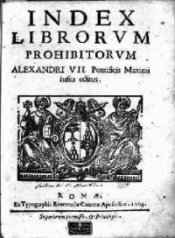|
Illuminations and Epiphanies
Banned Books
A Chronological Collection of
Banned Books
100 - 1500 A.D.
|
The Thalia. In 321 A.D.,
Arius, a theologian from Alexandria who taught that God the Father
and Jesus the Son had not existed together eternally, was denounced
at a Church synod by those who believed that both the Father and the
Son were part of a trinity that also included the Holy Spirit.
Arius's
position, as he expressed in the
Thalia,
became increasingly popular and dominated the powerful schools of
Alexandria, which produced the most influential theologians of the day.
By 325 A.D., the competition between beliefs had become so disruptive
to the Church that Emperor Constantine held an assembly of Bishops,
now known as the First Council of Nicea, in an effort to resolve the
controversy. That council, which was dominated by trinitarians,
condemned Arius and his writings and published the Nicene Creed which
includes the doctrine of Homousios or Consubstantiality (the sameness)
of Father and Son. Constantine exiled Arius and other bishops who
refused to accept the ruling of the Council and ordered all copies of
the Thalia to
be burned.
|
|
|
Decretum
Gelasianum de libris recipiendis et non recipiendis. Pope
Gelasius is generally credited with being the author of Church's first
list "of books to be admitted and not to be admitted" sometime during
his reign between 492 and 496 A.D. Some, however, contend that it is
possible to trace parts of this list back to Pope Damascus, and others
maintain that the list was not circulated until the middle of the 6th
century. Regardless, the Decretum
Gelasianum is the Church's
first official list of banned heretical and schismatic
apocryphal writings.
|
|
|
Sappho's Poetry. Sappho
was an acclaimed Greek poet who lived around 600 B.C. During her
lifetime, her works about love and longing were considered
masterpieces. Their content, though, had a definite woman-to-woman
element that was later found objectionable by the Church.
Christians began destroying her works in the 5th century A.D., and her
poetry was officially banned by Pope Gregory VII in 1073. The
destruction was so thorough that only one complete poem survived for
many centuries until a cache of papyri, discovered in the 1800s, that
had been used to wrap mummies and stuff sacred animals was found to
include her writings.
|
|
|
The Talmud. The Talmud, a
collection of scholarly oral discussions of Jewish law, ethics,
customs, and history, had long irritated Christian leaders who found
the open questioning of such matters completely at odds with the
Church's more closed and dogmatic epistemology. In 1225 Nicolas
Donin, a Parisian Jew was excommunicated by Yechiel ben Joseph,
the preeminent Talmudic scholar of the time, for continuously
questioning aspects Talmudic tradition. In turn, he converted to
Christianity, becoming a devoted Franciscan friar, and continued his
attacks on the Talmud.
He eventually secured an audience with
Pope Gregory IX and presented 35 indictments that he claimed
demonstrated the inherent
blasphemy of the Talmud.
Gregory, already suspicious of the Talmud,
was
partially convinced and subsequently ordered King Louis IX of France to
oversee a public "disputation" of the charges between Yechiel and
Donin. The pope found Donin's arguments more convincing, and
following the event, he ordered all copies the Talmud destroyed.
Between 1242 and 1244, tens of thousands of copies were destroyed, the
most spectacular destruction occuring in Paris when 24 wagon-loads of Talmuds were
burned at one time. (The Church launched subsequent attacks against the
Talmud over the next three hundred years until the European Jewish
communities agreed to expunge or alter those sections that the papacy
found to be blasphemous.)
|
|
|
To Ancient World
To The 1500s
|
|
